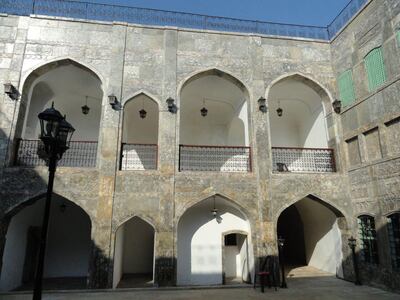The final stages of a major restoration project were almost complete when Beit Al Tutunji was reduced to rubble.
In 2014, the faded mansion in Mosul, Iraq, had finally regained its former grandeur.
The shaded iwans lined with calligraphic script, painted al fresco hallways and bas-reliefs carved in Mosul marble again made it among the finest examples of an Ottoman courtyard house in a city known for its evocative architecture.
But not long after, ISIS overran Mosul and Tutunji House became an artillery encampment before coalition air strikes destroyed its northern and western wings.
Now, like much of Mosul’s proud heritage, it is waiting to be pieced back together, rebuilt from the rubble brick by brick.
It is a daunting undertaking when so much of the city is in tatters after three years of ISIS rule. But rehabilitating Mosul’s heritage is about more than rebuilding historic sites.
“Cultural heritage preservation and protection form a critical and integral part of the larger post-conflict recovery effort in northern Iraq,” says Michael Danti, programme manager of the Mosul Heritage Stabilisation Programme, which is supporting the Iraqi restoration team at Tutunji House.
"Such activities are vital to peace building and the healing process.
“For centuries, the people of Mosul have carefully preserved heritage sites only to see this irreplaceable cultural legacy threatened in a few short years.”
Now they face a new hurdle as the coronavirus pandemic exacerbates existing challenges and interrupts rebuilding projects that provide much-needed employment as residents try to move on with their lives.
“Mosul was just starting to recover from the ISIS occupation and the damage it had caused to the social fabric, local economy and cultural heritage,” says Dr Richard Kurin, distinguished scholar and ambassador-at-large at the Smithsonian Institution.
The Smithsonian is leading the project to rehabilitate Mosul Museum in collaboration with the Iraqi State Board of Antiquities and Heritage.
“With the city in coronavirus lockdown, many people could not work and this put a tremendous stress on the financial well-being and morale of its families – just as it did in other countries, but maybe even more so in Mosul because of what its residents had been through,” Dr Kurin says.
Museums, libraries and other cultural venues were forced to close and rehabilitation work ground to a halt, leaving those whose livelihoods depend on the sites in a precarious position.
Last month, the Aliph Foundation in Abu Dhabi launched an emergency relief fund of $1 million (Dh3.6m) to support heritage projects and surrounding communities through the Covid-19 pandemic.
“The greatest impact is on the people and the communities that rely on this cultural heritage and the economies built up around it,” says Sandra Bialystok at the Aliph Foundation.
Set up in 2016, the foundation funds heritage projects in countries affected by conflict after the large-scale destruction of cultural heritage in the Middle East during recent years.
“Destroying culture and attacking people’s identity is a very, very old way of waging war and terror over people,” Ms Bialystok says.
One project is channelling Aliph funds towards restoring sculptures from the ancient city of Hatra, which was ransacked by ISIS in 2015.
When archaeology professor Massimo Vidale and his team first entered the remote site, they found many of the temples still standing but the sculptures that once adorned them were destroyed.
"We found, left in the bushes, most fragments of the sculptures. We will restore and replace them where they were," Mr Vidale told The National.
An ancient bridge between East and West, Hatra was possibly the first Arab kingdom in the chain of cities that included Palmyra, Baalbek and Petra.
Its Unesco-listed ruins, dating to the 3rd century BC, are among the most impressive archaeological sites in Iraq.
The Silk Road city had been heavily restored under Saddam Hussein, who sought to enhance his own prestige by turning Hatra into one of Iraq’s leading tourist attractions.
Demolishing it, Mr Vidale says, was an assault on the site’s modern significance and its historic legacy.
“The true target was western and far-eastern tourism, and the support that this globalised industry gives to the middle class, women's occupation and intercultural exchange and collaboration,” he says.
Rescuing its sculptures is a way to “reassess its extraordinary importance to the eyes of the international scientific audience", Mr Vidale says.
It will restore tourism to the site and the economy around it. “Everybody will see that the potential and fascination of ancient Hatra is still there.”
The last time Mr Vidale passed through Mosul, which is the closest major city to Hatra, the coronavirus had just started its global spread.
“Unaware people were trying to recover a minimum of social life, selling and drinking tea in plastic stalls along the banks of the Tigris. It was a touching sight,” he says.
Since then, protecting and preserving the city’s cultural heritage has become even more challenging, but no less important.
“Cultural heritage restoration provides important economic benefits to the traditional artisans and craftspeople of Mosul, and the work invests in the city's future," Mr Danti says.
"Without these projects, many cultural heritage sites might be forever lost, further adding to the impacts of the recent conflict."
At Mosul Museum, people are just beginning to go back to work as lockdown measures ease.
It has partially reopened but videos of ISIS militants taking sledgehammers to its artefacts are seared in recent memory.
For those restoring Iraq’s second-largest museum, rescuing the exhibits is part of the healing process.
“ISIS tried to destroy the museum in order to strip people of their heritage and sense of who they are," Dr Kurin says.
"Rehabilitating the museum can help the city rebuild its spirit and restore pride and esteem in people who were terrorised.
“It represents the importance of history, the value of knowledge, and the noteworthy civic, cultural and artistic achievements of the many communities that made Mosul and the region so significant to human civilisation.”














